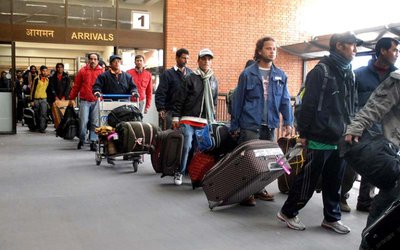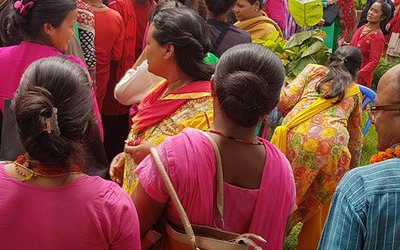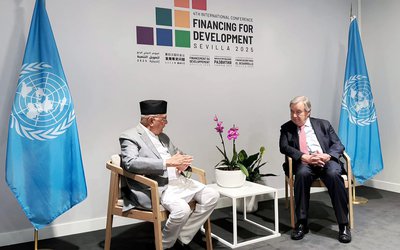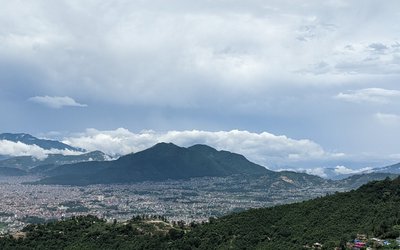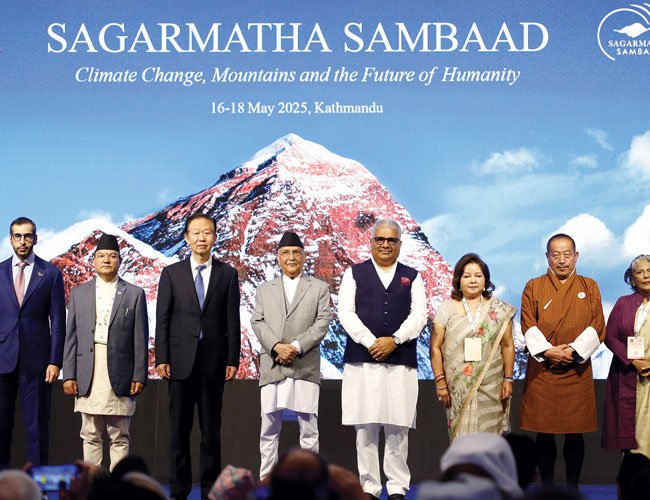
Nepal’s climate narrative is at a crossroads. The Sagarmatha Sambad, envisioned as a global dialogue platform, offers more than symbolic value-it serves as a mirror to critically assess our own climate journey. In the aftermath of the Sambad, we must go beyond diplomacy and declarations. This moment must become a transformative space to evaluate Nepal’s three-decade engagement on climate action and recalibrate our course.
Nepal faces the climate crisis firsthand: rising temperatures, erratic rainfall, glacial retreat, flash floods, and droughts are increasingly shaping everyday life. Yet our response remains fragmented, underfunded, and weakly implemented. This is not to dismiss past efforts-Nepal has developed climate policies, adaptation plans, and ratified global agreements since becoming a Party to the UNFCCC in the 1990s. But the fundamental question remains: has Nepal become more climate-resilient over the last three decades? For many researchers, development professionals, and local advocates, the honest answer is: not enough.
Despite having frameworks like the Climate Change Policy, National Adaptation Programmes of Action (NAPA), and National Adaptation Plans (NAP), vulnerable communities remain exposed, and adaptation efforts fall short. Why?
The Ownership Gap: Is Climate a Foreign Agenda?
Climate change is still widely perceived as a donor-driven issue, disconnected from the lived realities of farmers and frontline communities. International funding dominates the climate narrative, but overdependence has weakened domestic initiative and accountability. For some, climate engagement is more about gaining access to international platforms than building local resilience. Although there are dedicated champions across government and civil society, they are often overshadowed by bureaucratic inertia and political tokenism.
Shifting Discourse, Missing Priorities
Recent shifts show promise-more leaders now recognize the urgency of the crisis. The first Sagarmatha Sambad, with its climate focus, was a welcome step. However, we must ask: Does the discourse reflect critical introspection into Nepal’s own journey? Or are we using our vulnerability primarily to attract global funding and sympathy?
The Misplaced Emphasis
The most pressing challenge for Nepal is not mitigation, but adaptation. Shifting away from fossil fuels, investing in hydropower, and promoting electric mobility are all valuable long-term strategies for our economy, environment, and energy independence. However, we must be realistic: Nepal’s global emissions are negligible. Meanwhile, communities across the country are already suffering from extreme heat, unpredictable monsoons, and water insecurity. These events not only destroy infrastructure and displace communities but also erode agricultural productivity, food security, and public health. Despite these realities, our adaptation efforts remain inadequate. Adaptation must be prioritized-not as a token goal, but as a core national agenda. Having a NAP is not enough-where does it rank among national priorities? How much domestic budget is being allocated? Are adaptation interventions genuinely reaching the most vulnerable?
Climate Finance: Still Out of Reach
Our climate finance readiness is also inadequate. Despite decades of engagement in the UN climate process, only a handful of national institutions are accredited to access international climate finance mechanisms. While the call for developed countries to fulfill their financial commitments is valid, Nepal must also build its internal capacities-technical, institutional, and procedural-to access, mobilize, manage, and monitor climate finance-transparently and effectively.
Accountability Without Evaluation
Accountability is another missing piece. What have we achieved under the 2011 or 2019 Climate Change Policies, or under the NAPA? Are we on track to meet NAP targets set for 2025? There is no publicly accessible evaluation of progress or failures. We continue to develop new policies, plans, and NDCs-yet fail to evaluate or learn from existing ones. Without transparent, public assessments of success and failure, how can we claim credibility?
Neglected Diplomacy: China, India, and Transboundary Gaps
Nepal’s climate diplomacy remains too focused on the West, often overlooking regional collaboration. Our diplomatic strategy rarely engages India and China in addressing shared climate risks-particularly transboundary issues like glacial lake outburst floods (GLOFs). Strengthening regional cooperation, especially in the Himalayas and the Chure-Tarai-Ganga region, is critical. Sagarmatha Sambad must catalyze these discussions and ensure Nepal does not miss opportunities to bring its neighbors to the table, especially on collaboration in early warning systems, data sharing, and joint research.
Donor Priorities vs. Community Resilience
Furthermore, donor-driven priorities have skewed focus toward compliance tasks like emissions inventories and MRV systems, often at the cost of grassroots resilience. While the private sector is entering clean energy markets, adaptation lacks commercial incentives and still depends on public investment. Why are locally-led adaptation models, community seed banks, and watershed management projects still not scaled up? Why do local governments, empowered by federalism, still lack technical support and financial autonomy to lead?
Youth Voices: Global Slogans vs. Local Action
Nepali youth are vocal and active in the climate movement, but their platforms often mirror global campaigns like Fridays for Future. While this global solidarity is valuable, the real power of youth lies in raising local voices, pressuring local governments, and mobilizing communities. Sagarmatha Sambad should empower youth to move from protest to purpose-by becoming local innovators, storytellers, and solution-builders.
Nepal’s three-decade-long journey in the global climate arena is full of lessons. We've built international recognition, hosted high-level events, and submitted reports. But the true success lies not in speeches or side events, but in farmers who can irrigate their land during droughts, in flood-prone villages made safer, in young people who build resilience at home instead of migrating. We must ask ourselves: is our climate response truly rooted in our national needs and realities-or are we simply chasing global approval?
As we move forward from Sagarmatha Sambad, let it not be remembered as just another dialogue for display. Let it become a platform for truth-telling, reflection, and course correction. The government must lead-not merely as a negotiator in global forums, but as a protector of its people, with a response that is locally rooted, transparently financed, and deeply accountable. Nepal must reclaim its climate future-not as a passive recipient of aid, but as a proactive leader of resilience. The time for excuses is over. The next chapter must be one of action, not aspiration.
Lalmani Wagle is a graduate student at New Mexico State University, USA. He has over a decade of experience in Nepal's climate sector, working on national climate policy processes, and UN climate negotiations

